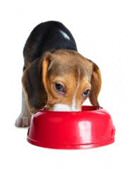We do not advise leaving food down throughout the day. Instead, food should be offered for a limited period of time (10 minutes) and any food that is left after this time should be discarded. This will create set meal times, rather than the dog grazing continuously. This is beneficial to help monitor your dog’s food intake more accurately, it will bond the dog to you more strongly and will also be very helpful for toilet training. It is also advisable to stick to one diet in particular and not swap between different brands as this can cause stomach upsets.
 There are many different feeding regimes to choose from: dry complete diets, semi-moist or tinned food and home-made diets. The most suitable diet should be easily digested and produce brown, firm, formed stools. If your dog produces soft or light stools or has wind or diarrhoea, then the diet may not suit your dog or he/she might have some kind of digestive problem, so consult your vet for advice
There are many different feeding regimes to choose from: dry complete diets, semi-moist or tinned food and home-made diets. The most suitable diet should be easily digested and produce brown, firm, formed stools. If your dog produces soft or light stools or has wind or diarrhoea, then the diet may not suit your dog or he/she might have some kind of digestive problem, so consult your vet for advice
Any change in diet should be made very gradually over at least 7 days to avoid upset and you should try feeding a new diet for at least 10 days before making any further changes.
At Viking Vets we stock Hills as our main canine diet as it contains DHA which is proven to improve vision and learning, something that is not found in other premium foods. It is a complete dog food so nothing extra needs to be added.
Dog Feeding Top Tips
- Clean fresh water should always be available. Dogs eating wet food (i.e. canned) will receive moisture through their food and therefore may consume less water than dogs eating dry food.
- Owners should not refill half empty bowls but ensure that fresh food is always provided at each meal time. This is particularly true in hot weather when food left in bowls can attract flies and other insects.
- Half full cans of dog food should be kept covered in the fridge but allowed to stand until the food is up to room temperature before feeding.
- Avoid feeding table scraps as these can upset the balance of nutrients provided by commercial prepared dog food and also encourage unwanted begging behaviour.
- Puppies have high energy requirements, but small stomachs, therefore owners should feed small meals frequently throughout the day. Follow the feeding instructions on the packaging.
- A healthy, fit dog is a happy dog! Owners should be able to feel their dog’s ribs under a small layer of protective fat, but not see them. The dog should also have a visible waistline. Always try to feed to maintain this condition.
- Owners should avoid any sudden change of their dog’s diet. A change from one food brand/flavour to another should be done gradually over a 7-10 day period. Any sudden change may upset the dog’s digestive system.
Treats
Treating is a good way to reward your dog during training to encourage the behaviour you want. There are a wide variety of prepared and natural treats on the market which vary hugely in quality. Treats should be taken into account when working out your puppy’s daily allowance of food. Therefore, their normal diet should be reduced accordingly to allow for the treats that have been given that day.
We do not advise feeding bones to your dog, especially cooked bones, as these can splinter and cause internal damage.